Great Garden Combo: Planting for Fiery Color and Beautiful Wildlife
There is something magical about seeing butterflies and hummingbirds in the summer garden. While butterflies flit gracefully from flower to flower, their colorful wings lazily dancing on the warm breeze, hummingbirds seem to always be in a great hurry, bobbing up and down, in and out and chasing off any intruders — such feisty little birds.
As well as providing us with many hours of entertainment, both of these creatures are important pollinators for our gardens, and as such it is worth taking time to encourage them to visit. When choosing a plant palette to satisfy their tastes, remember to plan for a succession of blooms over many months, and set these within a framework of bold foliage. This leafy backdrop will both enhance the floral display and hold the overall design together even when the flowers are not at their peak.
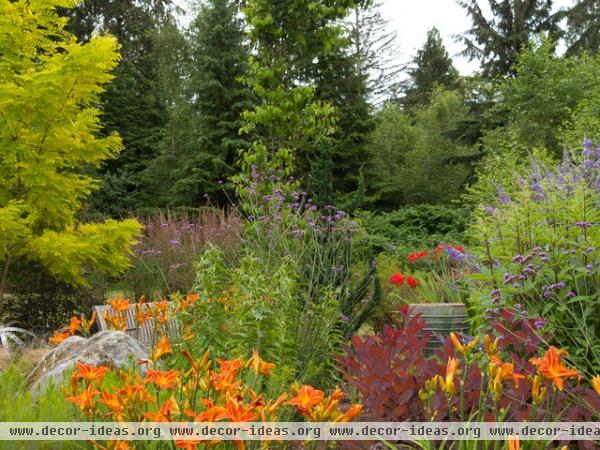
At first glance this is simply a well-designed summer combination, with fiery shades of burnt orange, burgundy and scarlet offset by cooling chartreuse. Yet this is a veritable buffet for both hummingbirds and butterflies, providing them with several months of nectar-rich flowers.
Tall verbena opens the floral symphony in late June, quickly followed by Flasher daylily, which pushes out dozens of vivid orange flowers for almost two months. The Lochinch butterfly bush joins in next, showing off endless fragrant lavender, panicle-type flowers while its silvery foliage becomes a striking backdrop for the well-known Lucifer crocosmia.
When these begin to fade, there is a large group of Joe pye weed ready to take center stage with their burgundy stems and flat rose-colored flower heads. These will continue to bloom with the tall verbena until the very end of summer.
Yet without a strong framework of foliage, all of these would be just a collection of pretty flowers. The golden locust tree and Grace smoke bush add solid blasts of color to satisfy our human desire for structure and ensure that our hummingbird garden is attractive to all garden visitors.
The finishing touch is a nearby bench. Not necessary, of course, but the perfect spot for enjoying the heady fragrance and watching beautiful garden visitors on a warm summer day.
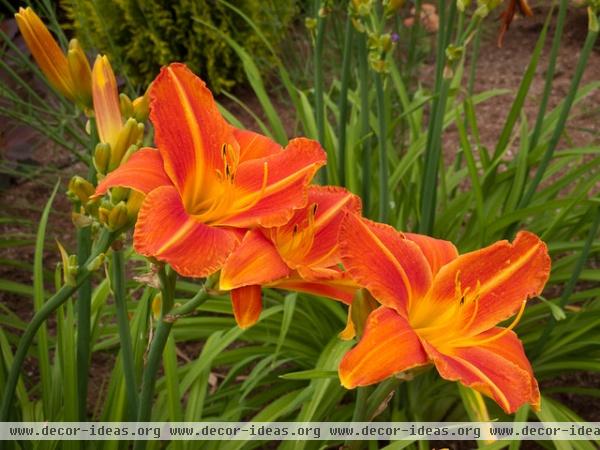
How to Get the Look
1. Choose Nectar-Rich Plants
Not all daylilies are equal. Many suffer from weak stems, untidy foliage and a short bloom time. Flasher daylily is different. The flowers are held high on sturdy stems and bloom for more than a month, while the foliage remains clean and needs minimal cleaning.
The burnt-orange color stands up to strong sunlight without fading and looks superb against dark foliage such as the Grace smoke bush shown in the opening combination.
Botanical name: Hemerocallis 'Flasher'
Common name: Flasher daylily
Benefits: Attracts hummingbirds, butterflies and bees
Where it will grow: Hardy to -40 degrees Fahrenheit (USDA climate zones 3a to 9b; find your zone)
Water requirement: Average to low
Light requirement: Full to partial sun
Mature size: 2 feet tall and 4 feet wide
Seasonal interest: Summer
When to plant: Spring or fall
Caution: Daylilies are toxic to cats; see other plants to keep away from pets.
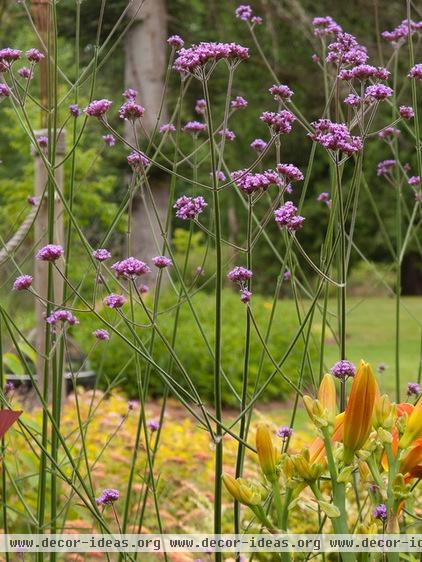
Tall verbena filters the view without obscuring it, adding a touch of mystery to the summer garden. Completely drought tolerant, it can be left to create its own plant combinations at will as it self-seeds with abandon. This is not a problem in my garden, where it is easy to remove unwanted seedlings.
Botanical name: Verbena bonariensis
Common name: Tall verbena
Benefits: Attracts hummingbirds, butterflies and bees
Where it will grow: Hardy to 0 degrees Fahrenheit (USDA climate zones 7 to 10)
Water requirement: Low
Light requirement: Full to partial sun
Mature size: 6 feet tall and 3 feet wide
Seasonal interest: Summer to fall
When to plant: Spring
Caution: Tall verbena is considered invasive in some parts of the U.S. Check with your local cooperative extension office for advice.
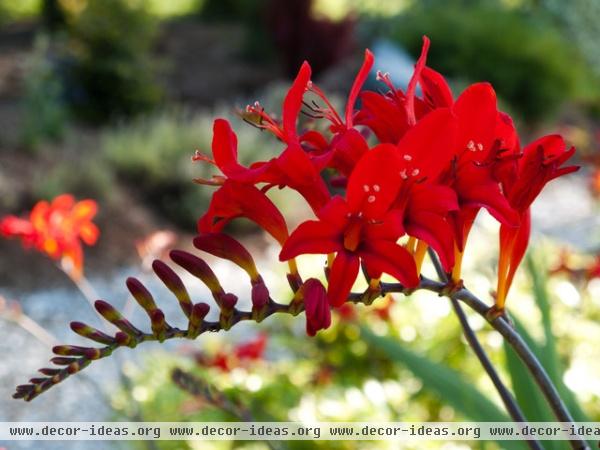
A stand of scarlet Lucifer crocosmia is an unforgettable sight in any summer garden. Arching stems of brilliant red flowers seem to explode from the swordlike foliage in summer, while hummingbirds vie for the best position like fighter pilots.
Botanical name: Crocosmia 'Lucifer'
Common names: Lucifer montbretia, Lucifer crocosmia
Benefits: Attracts hummingbirds
Where it will grow: Hardy to -20 degrees Fahrenheit (USDA climate zones 5 to 9)
Water requirement: Low
Light requirement: Full to partial sun
Mature size: 4 feet tall and wide
Seasonal interest: Summer
When to plant: Plant bulbs in spring; plants can also be planted in spring or fall.
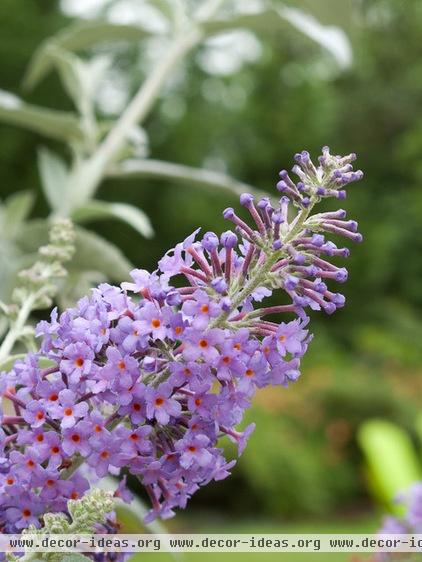
Butterfly bushes have gotten a bad reputation since appearing on many states' noxious weed lists. Do check to see which species are considered invasive in your area (if any), as you may unwittingly miss out on one of the most beautiful hybrids — Lochinch butterfly bush. Although the one in my Seattle garden is not sterile, I have never had a seedling from it.
The silvery felted foliage would be outstanding even if the plant never bloomed, but the fragrant lavender flowers, each with an orange eye, are what attracts hummingbirds, butterflies and bees by the dozen.
Cut this plant down to half size in spring to maintain a tidy shape.
Botanical name: Buddleia 'Lochinch' (syn. Buddleja x 'Lochinch')
Common name: Lochinch butterfly bush
Benefits: Attracts hummingbirds, butterflies and bees
Where it will grow: Hardy to -40 degrees Fahrenheit (USDA climate zones 3a to 9b)
Water requirement: Average to low
Light requirement: Full to partial sun
Mature size: 6 to 8 feet tall and wide
Seasonal interest: Spring to fall
When to plant: Spring
Caution: Although this hybrid is not listed, the species Buddleia davidii is considered invasive in some parts of the U.S. Check with your local cooperative extension office for advice.
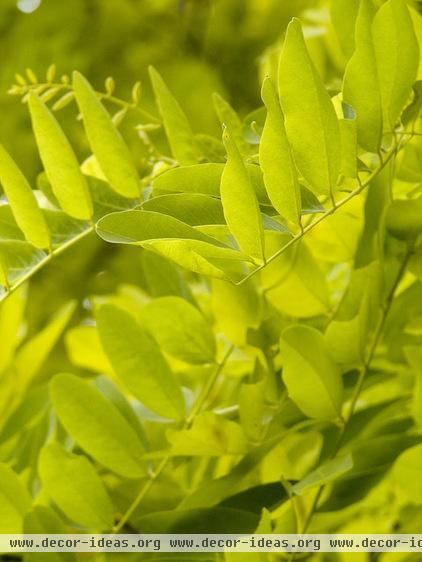
2. Extend the Show With Great Foliage
Hold a design together with great foliage, so it's eye catching even when flowers are not at their peak. This golden locust tree shines a foliage spotlight on the entire scene.
Botanical name: Robinia pseudoacacia 'Frisia'
Common name: Golden locust tree
Where it will grow: Hardy to -30 degrees Fahrenheit (USDA climate zones 4 to 9)
Water requirement: Low once established
Light requirement: Full sun for best color
Mature size: 30 to 50 feet tall and up to 20 feet wide
Seasonal interest: Spring to fall
When to plant: Plant it in well-drained soil in spring or fall.
Caution: Golden locust trees can produce unwanted suckers in some parts of the U.S.
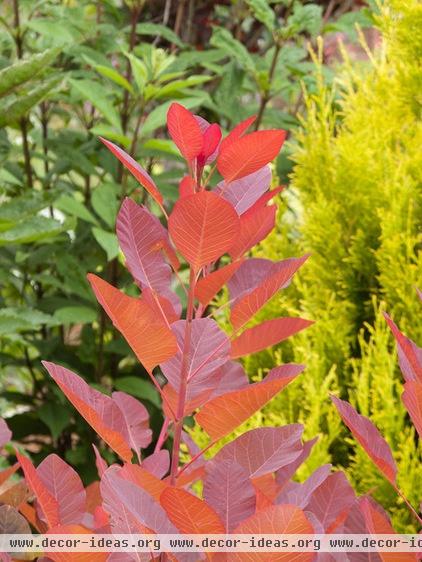
Grace smoke bush adds deeper tones with its rich burgundy leaves.
Botanical name: Cotinus ‘Grace’ (syn. Cotinus x 'Grace')
Common name: Grace smoke bush (syn. Grace smoke tree)
Where it will grow: Hardy to -30 degrees Fahrenheit (USDA climate zones 4 to 9)
Water requirement: Average to low
Light requirement: Full sun
Mature size: 10 to 15 feet tall and wide; 6 feet tall and wide with annual pruning
Seasonal interest: Spring to fall
When to plant: Spring or fall
Caution: Smoke bushes are considered invasive in some parts of the U.S. Check with your local cooperative extension office for advice.
See more ways to attract butterflies and bees












